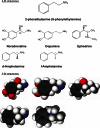Amphetamine, past and present--a pharmacological and clinical perspective
- PMID: 23539642
- PMCID: PMC3666194
- DOI: 10.1177/0269881113482532
Amphetamine, past and present--a pharmacological and clinical perspective
Abstract
Amphetamine was discovered over 100 years ago. Since then, it has transformed from a drug that was freely available without prescription as a panacea for a broad range of disorders into a highly restricted Controlled Drug with therapeutic applications restricted to attention deficit hyperactivity disorder (ADHD) and narcolepsy. This review describes the relationship between chemical structure and pharmacology of amphetamine and its congeners. Amphetamine's diverse pharmacological actions translate not only into therapeutic efficacy, but also into the production of adverse events and liability for recreational abuse. Accordingly, the balance of benefit/risk is the key challenge for its clinical use. The review charts advances in pharmaceutical development from the introduction of once-daily formulations of amphetamine through to lisdexamfetamine, which is the first d-amphetamine prodrug approved for the management of ADHD in children, adolescents and adults. The unusual metabolic route for lisdexamfetamine to deliver d-amphetamine makes an important contribution to its pharmacology. How lisdexamfetamine's distinctive pharmacokinetic/pharmacodynamic profile translates into sustained efficacy as a treatment for ADHD and its reduced potential for recreational abuse is also discussed.
Keywords: Abuse liability; amphetamine; attention deficit hyperactivity disorder (ADHD); drug formulations; lisdexamfetamine; microdialysis.
Conflict of interest statement
Figures






References
-
- Adderall XR U.S. Product Label Available at: http://dailymed.nlm.nih.gov/dailymed/drugInfo.cfm?id=49703 (accessed August 2012).
-
- Adler LA, Goodman DW, Kollins SH, et al. (2008) Double-blind, placebo-controlled study of the efficacy and safety of lisdexamfetamine dimesylate in adults with attention-deficit/hyperactivity disorder. J Clin Psychiat 69: 1364–1373 - PubMed
-
- Adler LA, Weisler RH, Goodman DW, et al. (2009) Short-term effects of lisdexamfetamine dimesylate on cardiovascular parameters in a 4-week clinical trial in adults with attention-deficit/hyperactivity disorder. J Clin Psychiat 70: 1652–1661 - PubMed
-
- American Psychiatric Association (1994) The diagnostic and statistical manual of mental disorders, fourth edition. Arlington, VA: American Psychiatric Association
-
- Arnold LE, Huestis RD, Smeltzer DJ, et al. (1976) Levoamphetamine vs dextroamphetamine in minimal brain dysfunction. Replication, time response, and differential effect by diagnostic group and family rating. Arch Gen Psychiat 33: 292–301 - PubMed
Publication types
MeSH terms
Substances
Grants and funding
LinkOut - more resources
Full Text Sources
Other Literature Sources
Medical
Miscellaneous

